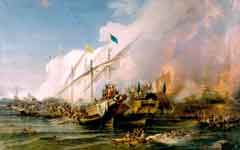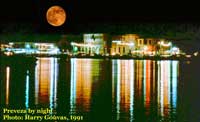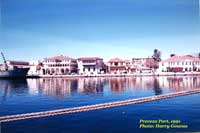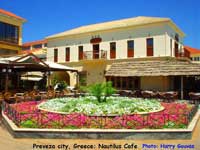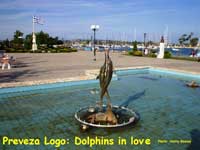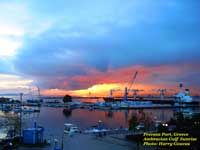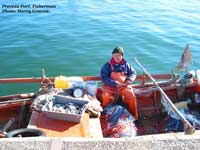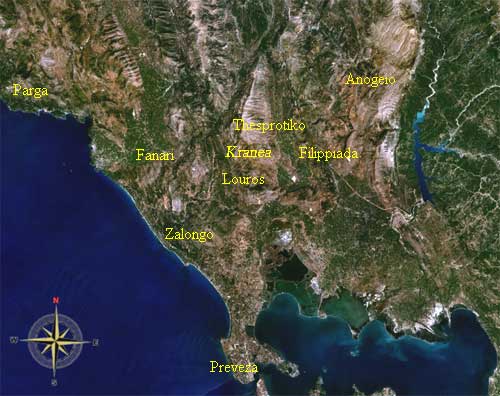.


Administrative Region : Epirus
Regional unit : Preveza
Preveza (Greek: Πρέβεζα) is a town in the periphery of Epirus, northwestern Greece, located at the mouth of the Ambracian Gulf. It is the capital of the peripheral unit of Preveza, which is part of the periphery of Epirus. An immersed tunnel, completed in 2002 which runs between Preveza and Actium, connects the town Preveza to western Acarnania in Aetolia-Acarnania region. The ruins of the ancient city of Nicopolis lie 7 km north of the city.
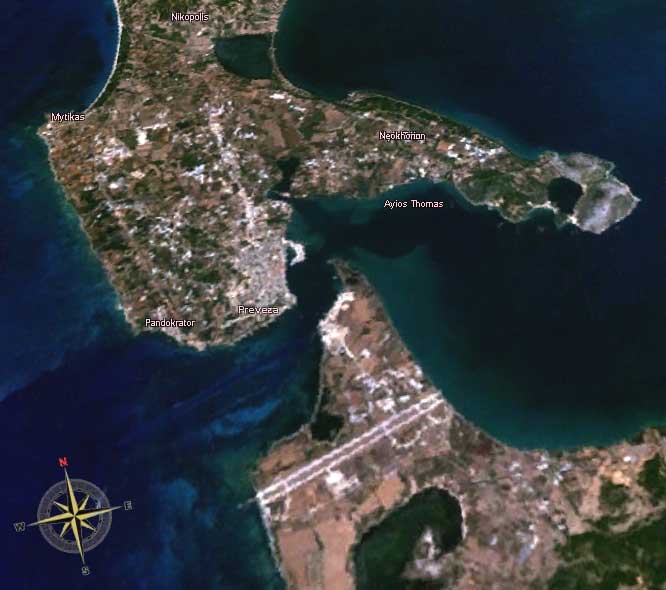
Preveza and the Aktion National Airport, Satellite Images, Greece
Name
The name Preveza is of uncertain etymology. There are three versions about the origin of word Πρέβεζα:
It might come from the old Slavic word perevoz meaning "crossing, passage" (Diogenes Charitonos and Fyodor Uspeski)[1] or
from the old Albanian word prevëzë-za, that means transportation (Petros Fourikis and Konstantinos Amantos),[1] or
from the Latin word prevesione, that means sustenance (victuals) (Max Vasmer, Peter Schustall, Johannes Conter),[2][3]
Municipality
The present municipality Preveza was formed at the 2011 local government reform by the merger of the following 3 former municipalities, that became municipal units (constituent communities in brackets):[4]
Louros (Ano Rachi, Kotsanopoulo, Louros, Neo Sfinoto, Oropos, Revmatia, Skiadas, Stefani, Trikastro, Vrysoula)
Preveza (Flampoura, Michalitsi, Mytikas, Nicopolis, Preveza)
Zalongo (Cheimadio, Ekklissies, Kamarina, Kanali, Kryopigi, Myrsini, Nea Sampsounta, Nea Sinopi, Riza, Vrachos)
History
Ancient
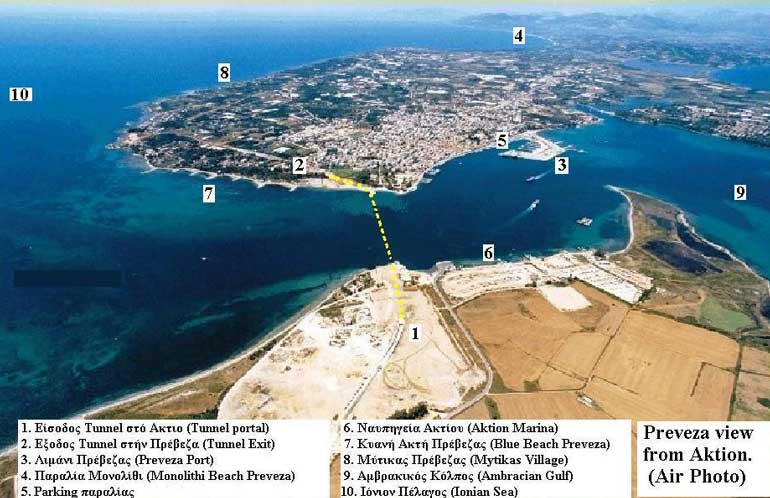
Immersed Tunnel Aktio - Preveza , copyright ©. Photos : Harry Gouvas https://www.facebook.com/people/Harry-Gouvas/100020340752017/
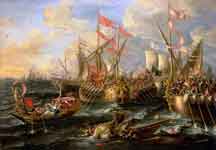
The Naval Battle of Actium. Lorenzo A Castro, painted 1672 National Maritime Museum, Greenwich,
Place also of the Battle of Actium 2 September 31 BC
The Naval Battle of Actium, by Lorenzo A.Castro (1672).
In antiquity, the area of Preveza was inhabited by the Greek tribe of the Cassopeans, part of Thesprotians. Their capital city was Cassope (near today's village of Kamarina). In the Louros District also exists a spectacular city, the Trikastron Citadel, built on three lines of defence walls of 9m heigh, published for first time in 2008.[5]
Near the site of modern Preveza in 290 BC King Pyrrhus of Epirus founded the town of Berenikia or Berenike, after his mother-in-law Berenice I of Egypt.,[6][7] Today it is widely accepted, that Berenike city lies on the hills of Michalitsi village, after Sotirios Dakaris excavations in 1965, and research and publications of Harry Gouvas in 2006, and 2009,.[2][8]
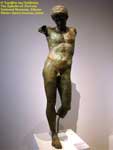
The Ambracian Gulf near Verenikia and the near part of Ionian sea, was the site of the Naval Battle of Actium, on 2 September 31 BC, in which Octavian's (later Augustus) forces defeated those of Mark Antony and Queen Cleopatra of Egypt. Ancient Nicopolis (Νικόπολις, "Victory City") was built nearby to commemorate Augustus' victory,[9] and today it is believed that had a total population of 150.000.[10]
Medieval
The Despotate of Epirus (left, in red) c.1204.
Nicopolis continued under Roman and later Byzantine rule, experiencing brief periods of Bulgarian rule in the 10th century (920-922, 977-983, 996-997). According to one theory, modern Preveza grew around a military outpost built in the 9th century by the Bulgarians, following their conquest of Nicopolis.[11]
The city was first attested in the Chronicle of Morea (1292).[12] However, Hammond places the foundation of Preveza much later, at the end of 14th century, possibly by Albanians.[13]
After 1204, it came under the Despotate of Epirus (1204–1230, 1241–1338, 1356–1358), the Second Bulgarian Empire (1230–1241), the Serbian Empire (1348–1356), and the Despotate of Arta (1358–1401).
It then came under Venetian rule until captured by the Ottomans.
The Venetian clock tower of the city.
Early Ottoman Rule
The monument of Zalongo.
The Turkish refounding of Preveza probably occurred in 1477 and Preveza was re-founded by the Ottomans in the late 15th century, with a subsequent strengthening of the fortifications in 1495.[14]
During Ottoman rule, it was the capital of the Karli İli sanjak (derived from Carlo II Tocco, Despot of Epirus) which comprised Aetolia-Acarnania), initially as part of the vilayet of Rumelia (1499–1670) and afterwards of the vilayet of Yannina (Ioannina).
The Naval Battle of Preveza was fought off the shores of Preveza in September 29, 1538, where the Ottoman fleet of Hayreddin Barbarossa defeated a united Christian fleet under the Genovese captain Andrea Doria. This day is a Turkish Navy National Holiday, and also some of today Turkish Submarines called "Preveze".
Ottoman rule was interrupted twice by periods of Venetian control, during the Morean War (1684–1699) and between 1717 and 1797.
In 1779, the Orthodox missionary Kosmas visited Preveza where it is said he founded a Greek school, which would be the only school of the city during the 18th century.[15] At the end of the 18th century, Preveza became a transit center of trade with western Europe (particularly France), which resulted in the increase of its population to approximately 10,000-12,000.[16]
Year of French Revolutionary rule, Ali Pasha's conquest and massacre
Battle of Nicopolis (1798)
Part of French Revolutionary Wars (specifically related to French Campaign in Egypt and Syria)
Date October 12, 1798
Location Environs of Preveza, near the ruins of Nicopolis
Result Decisive Ottoman victory
Belligerents
France French Army, Greek urban militia, Souliotes Ottoman Empire Ottoman troops, in practice serving Ali Pasha as a semi-independent ruler
Commanders and leaders
General La Salchette commanding French troops, Captain Christakis commanding Souliote warriors Ali Pasha Tepelena and his son Mukhtar
Strength
280 French Grenadiers, 200 Prevezian Civil Guards, 60 Souliote warriors 7000 Turkish and Albanian troops
Casualties and losses
Heavily decimated in battle and in the massacre which followed unknown
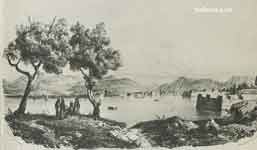
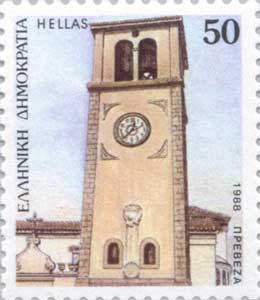
Preveza, Clocktower
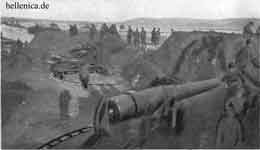
Preveza, Krupp guns of the enemy during the liberation in WWI

Greek Flags in Preveza after the Liberation, October 1912
|
|
|
|
|
|
|
|
|
|
|
|
|
|
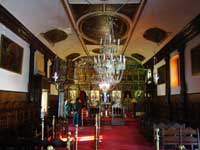
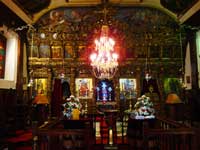
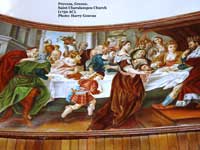
Agios Charalambos Church , Agios Charalambos Church , Agios Charalambos Church ,
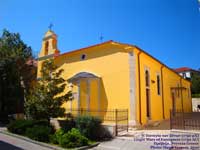
Following the Treaty of Campo Formio, where General Napoleon Bonaparte decreed the final dissolution of the Venetian Republic, Preveza - like other Venetian possessions in Greece and Albania - was ceded to Revolutionary France. Small French Army forces, consisting of about 280 Grenadiers, arrived in Preveza under the commands of General La Salchette. The people of Preveza welcomed French troops as friendly, as we see in letters of this period, when they wrote "ΠΕΑ" (First Year of Liberation)[17] and formed a pro-French civic militia. (It is noteworthy that at this same time the poet Rigas Feraios was combining support for the ideas of the French Revolution with calls for a Greek uprising against Ottoman rule, and that he was intercepted and killed by the Ottoman authorities when en route to meet Napoleon and directly ask for his help for the Greek cause).
Napoleon, however, focused his attention in another direction, launching the French Campaign in Egypt and Syria, placing France at war with the Ottoman Empire and giving little thought to the fate of the exposed small Preveza garrison on the edge of Ottoman territory. In October 1798, the local Ottoman governor Ali Pasha Tepelena - having great ambitions to make himself a semi-independent ruler - attacked Preveza with an overwhelming force.
In the Battle of Nicopolis on October 12, 1798[2] the 7000 Turkish and Albanian troops of Ali Pasha and his son Mukhtar completely overwhelmed the 280 French Grenadiers and their local allies - 200 Prevezian Civil Guards and 60 Souliote Warriors under Captain Christakis.
On the next two days, 13–14 October 1798, a major massacre of the French troops and the local Greek population which defended the city took place in Preveza and the Port Salaora on the Ambracian Gulf, starting before Ali Pasha entered Preveza on October 13 but continuing also in his presence.[18] The so-called "Hubbub of Preveza" ("Χαλασμός της Πρέβεζας") is still remembered as a notorious event in Greek history (el:Χαλασμός της Πρέβεζας).[19]
On October 14, Ali Pahsa called upon Prevezian citizens who had escaped to the Acarnanian Mountains to return to the city, and declared that they would be in no danger. However, upon their return 170 of them were executed by the sword at the Salaora Port Customs.[20]
Many prisoners who survived the massacre died from the hardships on the road to Ioannina. In the grand return and reception of for his victorious troops, which Ali Pasha organized at Ioannina, surviving Greek and French prisoners were given the unpleasant role of walking at the head of the procession, holding the cut and salted heads of their companions, under the shouts and jeers of Ioannina's Turkish and Albanian residents.
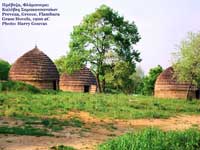
Flampoura, Sarakatsanoi hut dwelling, constructed of wood and straw

Castle of Nicopolis
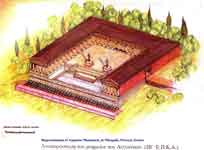
Nicopolis Monument of Augustus

Preveza Prefecture in the Antiquity and Later
From Ioannina, nine captured French grenadiers, and two officers were sent chained to Istanbul for questioning. One of them, Captain Louis-Auguste Camus de Richemont, was later released, possibly mediated by the mother of Napoleon Bonaparte, Marie Letitsia Bonaparte, and eventually became a General. Some popularly circulating tales, of doubtful historical authenticity, link this incident with the origins of the Spoonmaker's Diamond, one of the most closely guarded treasures of Istanbul's Topkapı Palace.
Though Preveza would remain under Ottoman rule for more than a century, this event - both the short period of Greek militias active in the city, and influenced by the ideas of the French Revolution, and the shock of the massacre which followed - had a part in the development of Greek nationalism towards the Greek War of Independence which broke out three decades later.
19th Century Ottoman Rule
The period from 1798 to 1822 is called 2nd Ottoman Occupation Period, when it was under the rule of the semi-independent Ali Pasha Tepelena. Following his tragic death in 1822 at Ioannina, Preveza entered into its 3d Ottoman occupation period, i.e. a rule more directly controlled from Istanbul, until the year 1912.
In 1835 educational activity in the city revived with the foundation of a new Greek school, the Theophaneios, named after its sponsor, Anastassios Theophanis. In the following decades this school became a center of education in the surrounding area and in 1851 it also hosted a female and a secondary school.[21]
In the later part of the 19th Century Preveza - like the whole of Epirus - became embroiled in the conflicting claims of Greek and Albanian nationalists. This came to a head which came to a head in the wake of the Russo-Turkish War, 1877-1878, when territorial changes in the hitherto Ottoman parts of the Balkans were put on the agenda.
The 1878 Congress of Berlin was inclined to ignore the demands of the newborn Albanian nationalism - Germany's Otto von Bismarck even proclaimed that an Albanian nation did not exist. Greek nationalism was far longer established on the European scene, and according to the treaty of Berlin in 1878 Preveza was to be ceded by the Ottoman Empire to the Kingdom of Greece.
On the other hand, the Albanian League of Prizren strongly objected to the Greek positions[22] through its local branch, the Albanian Committee of Preveza.[23][24] In 11 to 13 January 1879, 400 Albanian representatives - 200 Cham and Lab Albanian leaders jpined on the last day by 200 Northern Albanians - gathered in Preveza to attend the "Assembly of Preveza" (Albanian: Kuvendi i Prevezës) organized by the League of Prizren and its local committee.[25] The assembly resolved to create lobbying committees to would halt the Ottoman Empire ceding Epirus (or Chameria, as Albanians named the region) to Greece
The final demarcation of the border was to take place at Preveza, with delegates of Greece and the Ottoman Empire meeting at Preveza on February 6, 1879. Part of the population demonstrated, demanding that there be no such demarcation inside Epirus. On February 28, 1879, forty-nine delegates representing the Albanian population of the Ottoman Empire signed a petition in Preveza, with a threat to take arms to prevent an annexation of Preveza to Greece.
In the event, Albanian protests prevailed and only Arta was incorporated in Greece, leaving Preveza and the rest of Epirus under the Ottoman Empire for the time being.[26] Greek national ambitions were mollified by the Ottomans ceding Thessaly, in which Albanians had no interest. Greek claims to Preveza remained in force, however, and would come to the fore again in the Balkan Wars three decades later.
After the delineation of borders, the Ottoman empire changed the governor of Preveza and appointed one from Gjirokastër, in order to deal with the spreading nationalist activities of the Albanian population of Preveza, led by Abdyl Frashëri.[27][verification needed] On the other hand the Greek organization, Epirote Society, founded at 1906 by members of the Epirote diaspora, Panagiotis Danglis and Spyros Spyromilios, aimed at the annexation of the region to Greece[28] by supplying local Greeks with firearms.[29]
Modern History of Preveza
The city Preveza remained under Ottoman control until finally taken by the Greek Army on October 21, 1912, during the First Balkan War. The city was liberated (as Greeks saw it) after the Battle of Nicopolis, by the Greek Army forces under colonel Papagiotis Speliades. A garrison of the 8th Infantry Division (Greece) was in December placed in the city.
Later on in the same war, on 8 February, 1913, Preveza inhabitants were involved in the first case in world history of a combat pilot being shot down in combat. The Russian pilot N. de Sackoff, flying for the Greeks, had his biplane hit by ground fire following a bomb run on the walls of Fort Bizani. He came down near Preveza, and with the help of local townspeople repaired his plane and resumed flight back to base.[30]. In the following months arrived in Preveza the famous Swiss photographer Frederic Boissonnas, and a lot of photographs of this period are available today. Preveza along with the rest of southern Epirus formally became part of Greece via the Treaty of London.
In 1928 the famous poet Kostas Karyotakis lived in Preveza but only for 33 days, as he committed suicide, using a pistol, in the Vathy Margarona Place, Preveza[31]. Along with the rest of Greece, Preveza was occupied by Italy (1941–1943) and Germany (1943–1944) during World War II. After the departure of Wehrmacht from Preveza, in September 1944, a part of the Greek Civil War took place in Preveza, lasing 16 days and known as The Combat of Preveza.
At present Today Preveza is a commercial harbor and tourist hub, has a marina, two cinemas, an open theater, 100 Clubs, 100 Taverns, 50 Cafes, benefiting from its proximity to the nearby Aktion National Airport and the nearby island of Lefkada, a major tourist destination. The Aktio-Preveza Immersed Tunnel, released on 2002 is an important work of infrastructure for what has traditionally been a remote and underdeveloped region, and links Preveza to Actium (Greek: Άκτιο, Aktio) on the southern shore of the Ambracian Gulf, greatly shortening the distance of the trip to Lefkas.
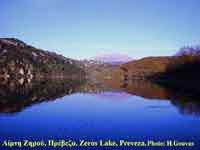
Notable sights
View of the promenade
The port with the City Hall
Acheron river canyon
Inside the new Preveza Municipality, there are a lot ancient and historical landscape sights for visiting. In the book "History of Preveza Prefecture" (Harry Gouvas, 2009) is available this index of sights[2]:
Ancient Nicopolis area (Walls, Basilica of Alkisson, Basilica of Dometius, Roman Odeum, Nympheum, Roman Baths, Cemetery, Theater, Augustus Monument, Roman Stadium, Roman Villa of Manius Antoninus etc.).
Ancient Kassopi citadel (400 BC), 25 km from Preveza.
Ancient Trikastron citadel (700 - 300BC), 30 km from Preveza.
Ancient Verenice city, Michalitsi village hills (270 BC).
Archaeological Museum of Nicopolis (2009).
St.Charalampos Church (1715–1793).
St.Varnavas Church.
St.Avassos Church.
Eleftherios Venizelos' statue in the central square of Preveza.
Forest of Lekatsas, in Myrsini village.
Fortress of Laskara, Ali Pasha period (1810).
Fortress of Pantokrator, Ali Pasha period (1810).
Fortress of St. Andreas, Venetian (1701–1717) and Ottoman period (1810).
Fortress of St. George (1718).
Fortress of Reniassa (or Fortress of Despo) in Riza (1280).
St.Elias prophet church (1780).
Immersed tunnel of Preveza – Aktion (2002).
Kostas Karyotakis' statue and last residence.
Madonna Church of Foreigners (Panagia ton Xenon) (1780).
Monolithi beach and Monolithi forest.
The building of the National Bank of Greece (1931).
Odysseus Androutsos' marble statue.
Ottoman baths of Ali Pasha Tepelena.
Seytan Pazar, traditional street.
St. Thomas port.
Margarona traditional boatyard.
Venetian clock tower of Preveza.
Zalongo monument.
Notable natives and residents
Mosaic from the Roman Villa of Manius Antoninus
The building of the National Bank of Preveza
Roe caviar of Preveza
Sunrise in Actium
Abedin Dino, founding member of the League of Prizren and leading figure of the Albanian National Awakening.
Athanasia Tsoumeleka, athlete and Olympic Games Gold winner, in Fast Running.
Alexios Vlahopoulos, hero of the Greek War of Independence.
Ali Dino (1890–1938), famous Albanian cartoonist and member of the Hellenic Parliament.
Athina Papayianni, athlete.
Evaggelos Avdikos, sociologist, professor of University of Larissa.
Harry Gouvas, medical doctor, MD, PhD, writer, & director of foundation "The Museum of Arts and Sciences Harry Gouvas" in Preveza.
Jannis Kallinikos, scholar and intellectual.
Kostas Provatas (1906–2001), popular painter from Nikopolis.
Nikolaos Konemenos (1837–1906), scholar.
Nikos Karabelas, writer and president of the foundation "Actia Nicopolis" in Preveza.
Kleareti Malamou-Dipla (1898–1977), poet and writer.
Rasih Dino (1865–1928), diplomat and signatory of Albania to the Treaty of London.
Shahin Dino, deputy of the sanjak of Preveza in the Ottoman Parliament and later Minister of Interior of Albania.
Theodoros Grivas (1797–1862), hero of the Greek War of Independence.
Thrasyvoulos Tsakalotos (1897–1989), Hellenic Army chief and ambassador.
Clubs in Preveza
Syrrako Village People Club. Established by ...... Year...... Members: 500. Website:http://www.epirusinfo.com Phone:
Choir Armonia of Preveza. Established by ...... Year...... Members: 60. Website:http://www.choir.gr/armonia.htm Phone:
Alpine Club of Preveza. Established by Harry Gouvas. Year 1990. Members: 150. Website:http://eosprevezas.blogspot.com/ Phone:
Lefkas Island people Club. Established by ...... Year...... Members: .... Website: Phone:
Commando's Club of Preveza. Established by ...... Year...... Members: .... Website:http://efedreia.blogspot.com Phone:
Motorbike Club of Preveza. Established by ...... Year...... Members: .... Website:http://www.lemop.gr Phone:
Informatics Club of Preveza. Established by Harry Gouvas. Year 1994.
Folk Music Club Verenice, of Preveza. Established by Evangelos Bakolas. Year 1996 Members: 200. Phone:
Photography Club of Preveza. Established by ...... Year...... Members: .... Website:http://www.efeprevezas.gr/ Phone:
Transportation
Preveza is linked by road to Igoumenitsa and other coastal settlements through the E55 national road, and is also linked with other cities in Epirus such as Ioannina and Arta. The Aktio-Preveza Undersea Tunnel links Preveza by road to Aetolia-Acarnania in Central Greece. Preveza also has a small commercial and passenger port and is served by the nearby Aktion National Airport, which also serves the island of Lefkada.
Historical population Statistics
Year Town population Municipality population
1981 13,624 -
1991 13,341 16,886
2001 16,321 19,605
International relations
See also: List of twin towns and sister cities in Greece
Twin towns - Sister cities
Preveza is a founding member of the Douzelage, a unique town twinning association of 24 towns across the European Union. This active town twinning began in 1991 and there are regular events, such as a produce market from each of the other countries and festivals.[32][33] Discussions regarding membership are also in hand with three further towns (Agros in Cyprus, Škofja Loka in Slovenia, and Tryavna in Bulgaria).
Spain Altea, Spain - 1991
Germany Bad Kötzting, Germany - 1991
Italy Bellagio, Italy - 1991
Republic of Ireland Bundoran, Ireland - 1991
France Granville, France - 1991
Denmark Holstebro, Denmark - 1991
Belgium Houffalize, Belgium - 1991
Netherlands Meerssen, the Netherlands - 1991
Luxembourg Niederanven, Luxembourg - 1991
Greece Preveza, Greece - 1991
Portugal Sesimbra, Portugal - 1991
United Kingdom Sherborne, United Kingdom - 1991
Finland Karkkila, Finland - 1997
Sweden Oxelösund, Sweden - 1998
Austria Judenburg, Austria - 1999
Poland Chojna, Poland - 2004
Hungary Kőszeg, Hungary - 2004
Latvia Sigulda, Latvia - 2004
Czech Republic Sušice, Czech Republic - 2004
Estonia Türi, Estonia - 2004
Slovakia Zvolen, Slovakia - 2007
Lithuania Prienai, Lithuania - 2008
Malta Marsaskala, Malta - 2009
Romania Siret, Romania - 2010
See also
Actium
The Naval Battle of Actium (31 BC)
Ancient Nicopolis (31 BC)
The Naval Battle of Preveza (1538 AC)
The Battle of Nicopolis-Preveza (1798 AC)
The Combat of Preveza, Greek Civil War (1944 AC)
The Aktio-Preveza Undersea Tunnel (2003 AC)
The Assembly of Preveza (1992 AC)
New Archaeological Museum of Nicopolis (2009 AC)
List of settlements in the Preveza prefecture
Preveza (peripheral unit)
References
^ a b Petros Fourikis: "Nikopolis Preveza" first edition, Athens 1930
^ a b c d Harry Gouvas: "History of Preveza Prefecture", edition 2009, ISBN 978-960-87328-2-7
^ Max Vasmer: "Die Slaven in Griechenland", 1970 (reprint), p. 64 "Preveza"
^ Kallikratis law Greece Ministry of Interior (Greek)
^ Harry Gouvas: "Ancient Trikastron Citadel: The Mountain base of King Pyrrhus?", newspaper Topiki Phoni, 28 March 2008
^ Plutarch: Life of King Pyrrhus, Kaktos editions, Athens
^ Green, Peter (1993). Alexander to Actium: the historical evolution of the Hellenistic age. Hellenistic culture and society. University of California Press. p. 123. ISBN 0520083490.
^ Harry Gouvas:"Did we found ancient Verenice?". Newspaper Topiki Phoni of Preveza, 2006
^ Plutarch: Life of Marc Antony, vol.III
^ Konstantinos Zachos: "Ancient Nicopolis", The Greek Ministry of Culture,2003
^ Guide Bleu, Greece. Hachette-Livre, 2000. p.680
^ Isager Jacob. Foundation and destruction, Nikopolis and Northwestern Greece. Danish Institute at Athens, 2001, ISBN 9788772887340, p. 47.
^ Hammond, Nicholas Geoffrey (1967). Epirus: The Geography, The Ancient Remains, The History and the Topography of Epirus and Adjacent Areas. Oxford University Press. p. 46. Retrieved 2010-06-10.
^ Isager Jacob: "Foundation and destruction, Nikopolis and Northwestern Greece". Danish Institute at Athens, 2001, ISBN 9788772887340, p. 60.
^ Sakellariou M.V.:"Epirus, 4000 years of Greek history and civilization", Ekdotikē Athēnōn, 1997, ISBN 9789602133712, p. 306
^ Mikropoulos A. Tassos:Elevating and Safeguarding Culture Using Tools of the Information Society: Dusty traces of the Muslim culture. Earthlab. ISBN 9789602331873, p. 313-315.
^ Kostas Filos: Collection of private Letters of 18th century, "The Museum of Arts and Sciences Harry Gouvas", in Preveza
^ Fleming Katherine Elizabeth: The Muslim Bonaparte: Diplomacy and Orientalism in Ali Pasha's Greece. Princeton University Press, 1999. ISBN 978-0-691-00194-4, p. 99
^ Dr.Harry Gouvas:"History of Preveza Prefecture", 2009, ISBN 978-960-87328-2-7
^ Nikos Karabelas: "Foreign travellers in Preveza", Newspaper Kathimerini, 28 Jan 2001
^ Sakellariou M. V.: "Epirus, 4000 years of Greek history and civilization". Ekdotikē Athēnōn, 1997, ISBN 9789602133712, p. 306
^ Medlicott William Norton. Bismarck, Gladstone, and the Concert of Europe University of London, Athlone Press, 1956, p. 77
^ Jelavich, Barbara (1989). History of the Balkans: Eighteenth and nineteenth centuries. The Joint Committee on Eastern Europe Publication Series. Cambridge University Press. p. 365. ISBN 0521274583.
^ Skendi, Stavro (1967). The Albanian national awakening, 1878-1912. Princeton University Press. p. 70.
^ Anamali, Skënder and Prifti, Kristaq. Historia e popullit shqiptar në katër vëllime. Botimet Toena, 2002, ISBN 99927-1-622-3.
^ Gawrych, George (2006). The crescent and the eagle: Ottoman rule, Islam and the Albanians, 1874-1913. I.B.Tauris. pp. 54. ISBN 1845112873.
^ Ortayli, İlber (1998). Belleten. Belleten. 62. Türk Tarih Kurumu. p. 153. Retrieved 3 October 2010.
^ Sakellariou, M. V. (1997). Epirus, 4000 years of Greek history and civilization. Ekdotike Athenon. pp. 310. ISBN 9789602133712.
^ Sakellariou, M. V. (1997). Epirus, 4000 years of Greek history and civilization. Ekdotike Athenon. pp. 360. ISBN 9789602133712.
^ Baker, David, "Flight and Flying: A Chronology", Facts On File, Inc., New York, New York, 1994, Library of Congress card number 92-31491, ISBN 0-8160-1854-5, page 61.
^ Harry Gouvas: "History of Preveza Prefecture" edition 2009
^ "Douzelage.org: Home". www.douzelage.org. Retrieved 2009-10-21.
^ "Douzelage.org: Member Towns". www.douzelage.org. Retrieved 2009-10-21.
|
Municipalities and communities of the Preveza Prefecture
Anogeio | Fanari | Filippiada | Louros | Parga | Preveza | Thesprotiko | Zalongo |
| Municipal unit Preveza |
|---|
|
Municipal Community Preveza
|
| Agios Thomas (Άγιος Θωμάς, ο) |
| Kalamitsi (Καλαμίτσι, το) |
| Neochori (Νεοχώρι, το) |
| Preveza (Πρέβεζα, η) |
| Psathaki (Ψαθάκι, το) |
| Community Michalitsi |
| Agios Nikolaos (Άγιος Νικόλαος, ο) |
| Michalitsi (Μιχαλίτσι, το) |
| Community Mytikas |
| Mytikas (Μύτικας, ο) |
| Community Nikopoli |
| Mazoma (Μάζωμα, το) |
| Nikopoli (Νικόπολις, η) |
| Community Flampoura |
| Flampoura (Φλάμπουρα, τα) |
Greece :
A - B - C - D - E - F - G - H - I - J - K - L - M -
N - O - P - Q - R - S - T - U - V - W - X - Y - Z
Retrieved from "http://en.wikipedia.org/"
All text is available under the terms of the GNU Free Documentation License


